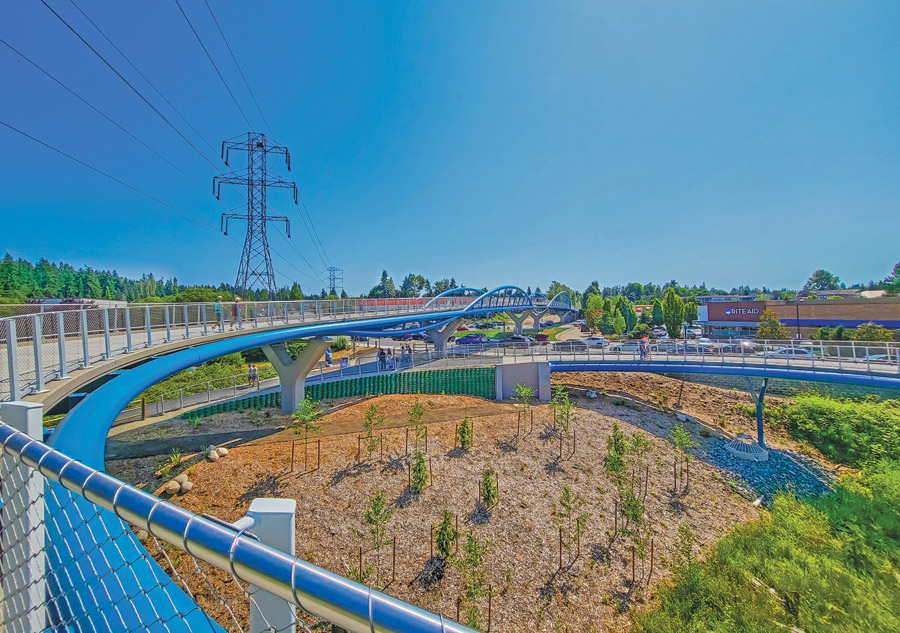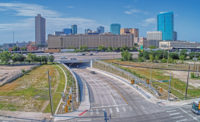ENR Northwest 2024 Best Projects
Best Highway/Bridge: Totem Lake Connector

Photo courtesy COWI North America Inc.
TOTEM LAKE CONNECTOR
Kirkland, Wash.
BEST PROJECT
Submitted by: COWI North America Inc.
OWNER: City of Kirkland
LEAD DESIGN FIRM/STRUCTURAL: COWI North America Inc.
GENERAL CONTRACTOR: Kraemer North America LLC
CIVIL ENGINEER: MIG
GEOTECHNICAL/ENVIRONMENTAL ENGINEER: GeoEngineers Inc.
ARCHITECT/PUBLIC OUTREACH: Perkins Eastman (Formerly VIA)
CONSTRUCTION MANAGER: David Evans & Associates
LIGHTING/ELECTRICAL DESIGN: DMD & Associates Electrical Consultants Ltd.
SURVEY AND MAPPING: 1 Alliance (Now Atlas)
SUBCONTRACTORS: Malcolm Drilling; Transcon Co.; Pacific Steel Group; BendTec
A 795-ft bicycle and pedestrian bridge now connects to the Cross Kirkland Corridor across one of the city’s most complicated and busy intersections. The $13.6-million bridge includes five truss spans—including two over traffic—while another six spans form the northern loop ramp over wetlands.
Commercial development surrounds the project site, which has been identified for possible future transit facilities. The connector safely grade separates this trail from traffic and features a 14-ft bridge deck, plus a wider rest area over the traffic island in the intersection. It’s also setting an example for other adjacent cities, which are following in Kirkland’s footsteps to create a continuous trail through the corridor.
Approach grades and layouts were set to provide a steady and gradual slope for pedestrians and bicyclists while minimizing impacts to the environment and other infrastructure. The arched Vierendeel trusses are composed of pipe members, with the truss planes splayed out to minimize the footprint below deck.

Photo courtesy David Evans & Associates
Previously, the intersection was a significant impediment to trail users and redevelopment in the neighborhood was just beginning. From the beginning of design, the project team had to tackle a slew of site constraints, including property access, a wetland, ditches, existing buried utilities and multiple overhead power transmission lines. The congested site also had heavy traffic and potentially hazardous materials from an abandoned railroad. The team developed an alignment to avoid major conflicts with each of these elements.
To minimize impacts within the wetlands, steel Y-piers were designed on single drilled shafts, allowing for planting and restoration throughout the site. Although a smaller sanitary sewer was relocated, the north abutment was designed around a critical Northshore Utility District sewer that remained in place.

Photo courtesy COWI North America Inc.
Meanwhile, keeping the loop ramp light helped significantly with seismic design because soils throughout the north loop ramp were poor and subject to liquefaction and lateral spreading during an earthquake. The design leveraged the geometric stiffness of the loop ramp and the rigid north abutment to keep the pier footprints small.
The design team saw an opportunity with retaining walls along the approaches to put sustainability at the forefront of design. Rather than traditional concrete-faced walls, the team chose vegetated mechanically stabilized earth (MSE) walls, which also allowed for installation of stormwater infiltration under the approaches. The approaches were also paved with porous hot mix asphalt (HMA) to reduce the amount of runoff. Two stormwater infiltration ponds are located under spans one and three.

Photo courtesy COWI North America Inc.
Ensuring pedestrian comfort on the long extensions off such a slender structure was another challenge. Walkways extend 20 ft to the outside and 12 ft to the inside of the loop ramp deck, centered over the pier closest to the wetlands. Although not commonly used in transportation structures, the solution was leaving space at the end of each overlook for vibration dampers, specifically calibrated to prevent buildup of pedestrian induced vibrations.

-04_ENRready.jpg?height=200&t=1668199635&width=200)

